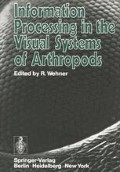Abstract
No evidence is found that the bee can form a concept of ‘triangularity’ as suggested by MAZOCHIN-PORSHNYAKOV. The amount of contour per unit area of a shape appears to be of overwhelming importance in the ability of the bee to make discriminations, as well as in its spontaneous preference for certain shapes. Bees can be made to utilize other parameters by training along a decreasing continuum of contour per unit area. Thus there may be attentional mechanisms in bees similar to those found in vertebrates.
Access this chapter
Tax calculation will be finalised at checkout
Purchases are for personal use only
Preview
Unable to display preview. Download preview PDF.
References
HEBB, D.O.; Alice in Wonderland or psychology among the biological sciences. In Biological and Biochemical Bases of Behaviour, ed. HARLOW, H.F. and WOOLSEY, C.N. pp 451 – 467. University of Wisconsin Press (1958).
HERTZ, M.; Die Organisation des optischen Feldes bei der Biene. Part 1: Z. vergl. Physiol. 8, 693 – 748 (1929).
HERTZ, M.; Die Organisation des optischen Feldes bei der Biene. Part 2: Z. vergl. Physiol. 11, 107 (1930).
HERTZ, M.; Die Organisation des optischen Feldes bei der Biene. Part 3: Z. vergl. Physiol. 14, 629 (1931).
MAZOCHIN-PORSHNYAKOV, G.A.; Die Fähigkeit der Bienen, visuelle Reize zu generalisieren. Z. vergl. Physiol. 65, 15 – 28 (1969b).
MAZOCHIN-PORSHNYAKOV, G.A.: Generalisation of visual stimuli as an example of solution of abstract problems by bees. Zool. Jb. 48, 1125 – 1136 (1969a).
MAZOCHIN-PORSHNYAKOV, G.A.: Insect vision, pub. Plenum Press, New York (1969c).
WEHNER, R.: The generalisation of directional visual stimuli in the honey bee, Apis mellifera. J. insect. Physiol. 17, 1579 – 1591 (1971).
WOLF, E.: Das Verhalten der Bienen gegenüber flimmernden Feldern und bewegten Objekten. Z. vergl. Physiol. 20, 151 (1934).
WOLF, E.: Flicker and the reaction of bees to flowers. J. Gen. Physiol. 20, 511 (1937).
ZERRAHN, G.: Formdressur und Formunterscheidung bei der Honigbiene. Z. vergl. Physiol. 20, 117 – 150 (1934).
Author information
Authors and Affiliations
Editor information
Editors and Affiliations
Rights and permissions
Copyright information
© 1972 Springer-Verlag Berlin · Heidelberg
About this chapter
Cite this chapter
Anderson, A. (1972). The Ability of Honey Bees to Generalise Visual Stimuli. In: Wehner, R. (eds) Information Processing in the Visual Systems of Anthropods. Springer, Berlin, Heidelberg. https://doi.org/10.1007/978-3-642-65477-0_30
Download citation
DOI: https://doi.org/10.1007/978-3-642-65477-0_30
Publisher Name: Springer, Berlin, Heidelberg
Print ISBN: 978-3-540-06020-8
Online ISBN: 978-3-642-65477-0
eBook Packages: Springer Book Archive

